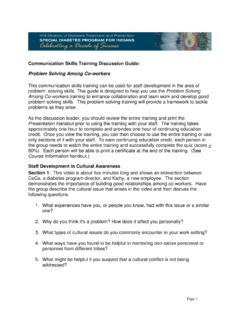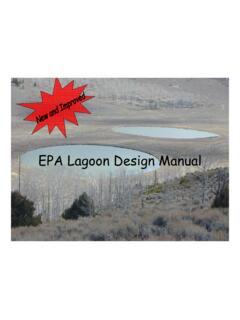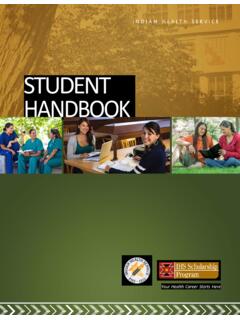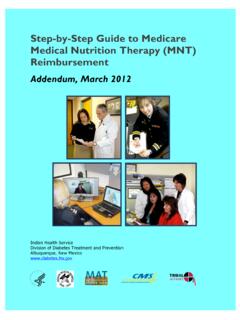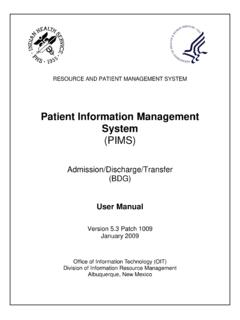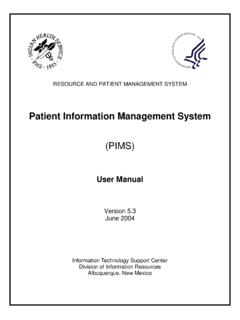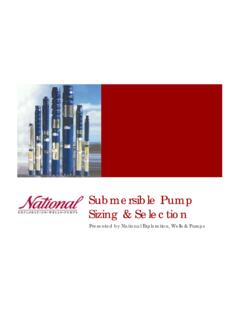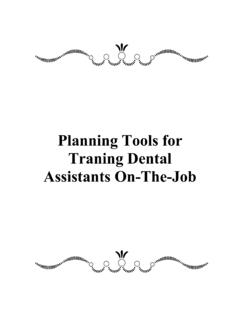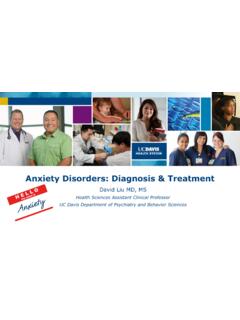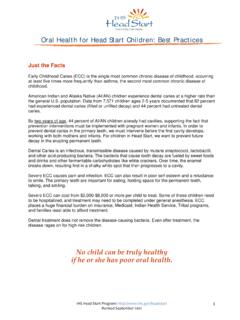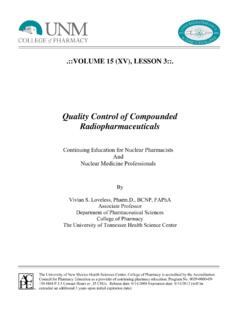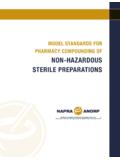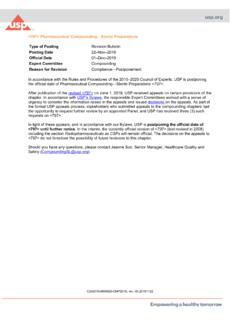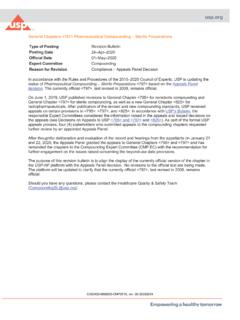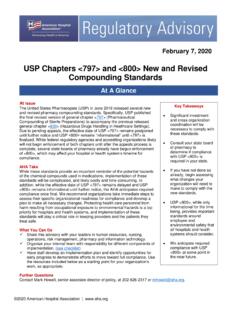Transcription of Chapter 21-4.1.0 - Design Requirements for Compounded ...
1 Oct 31, 2017 Chapter - Design Requirements FOR Compounded STERILE AND HAZARDOUS DRUG PREPARATION AREAS 1 A. Purpose .. 1 B. Scope .. 1 C. Background .. 1 D. Definitions .. 2 4 A. General Design Criteria for facilities .. 4 B. Design Criteria for facilities using BSCs and LAFWs .. 6 C. Design Criteria for facilities using CAIs and CACIs .. 6 D. Typical Room Layouts .. 7 Tables: Construction Guidelines for Pharmacy Compounding 8 Table 1: Requirements Common to All Locations and Compounded Pharmaceuticals .. 8 Table 2A: Standard Requirements for Low and Medium Risk CSPs .. 9 Table 2B: Reduced Requirements for Low and Medium Risk CSPs in Compliant Isolators .. 10 Table 3: Requirements for Low Risk CSPs w/ BUD <12 hours .. 11 Table 4: Requirements for High Risk CSPs.
2 12 Table 5: Requirements for Non-sterile Hazardous Drug Manipulations .. 13 INTRODUCTION A. Purpose This Chapter provides guidance on minimum Requirements for the designing of IHS pharmacies to ensure safe and contamination free storage and processing of Compounded sterile preparations (CSP) and hazardous drugs (HD). B. Scope This Section 10 of Chapter 21-4 applies to all new construction and renovation for IHS health care facilities.* This Section addresses aspects of the built environment, , architectural, mechanical, and electrical, etc., as these relate to the environmental conditions for compounding sterile preparations and storage and processing of hazardous drugs. This document should be used in conjunction and/or consultation with the IHS Pharmacist, the Area Institutional Environmental Health officer, and the Director of Facilities Management.
3 Oct 31, 2017 * Note: For facilities constructed prior to the adoption date of this section and not otherwise scheduled for renovation, the multi-disciplinary team listed above should evaluate facility compounding needs, practices, equipment, and environment to determine appropriate actions to address United States Pharmacopeia (USP) 797-2008 and USP 800-2016. C. Background In 2002, the Centers for Disease Control and Prevention (CDC) published a Morbidity and Mortality Weekly Report, which advised that clinicians should consider the possibility of improperly Compounded medications as a source of infection in patients. This recommendation from the CDC was the beginning of an increased focus to provide controlled environments and practices when compounding sterile preparations.
4 This update reflects incorporation of updated Requirements from the publication of USP 797 (2008) and the initial issuance of USP 800 (2016). Previous editions of this Technical Handbook Chapter . Dec 9, 2008 D. Definitions Ante Area/Room An International Standards Organization (ISO) Class 8 or better area/room where personnel hand hygiene and garbing procedures, staging of components, order entry, CSP labeling, and other high- particulate generating procedures are performed (USP-797-2008). Biological Safety Cabinet (BSC) A ventilated cabinet for protection of Compounded Sterile Preparations, personnel, product and/or the environment, which has an open front with inward airflow for personnel protection, downward high-efficiency particulate air (HEPA)-filtered laminar airflow for product protection, and HEPA-filtered exhausted air for environmental protection (USP-797-2008).
5 Buffer Area/Zone An ISO Class 7 or better area/zone where the primary engineering control (PEC) is physically located (USP-797-2008). Compounding Aseptic Containment Isolator (CACI) A compounding aseptic isolator (CAI) designed to provide worker protection from exposure to undesirable levels of airborne drug throughout the compounding and material transfer processes and to provide an aseptic environment for compounding sterile preparations. Oct 31, 2017 Air exchange with the surrounding environment should not occur unless the air is first passed through a microbial retentive filter (HEPA minimum) system capable of containing airborne concentrations of the physical size and state of the drug being Compounded . Where volatile hazardous drugs are prepared, the exhaust air from the isolator should be appropriately removed by properly designed building ventilation.
6 (USP-797-2008) Compounding Aseptic Isolator (CAI) A form of isolator specifically designed for compounding sterile, non-hazardous pharmaceutical ingredients or preparations. It is designed to maintain an aseptic compounding environment within the isolator throughout the compounding and material transfer processes. Air exchange into the isolator from the surrounding environment should not occur unless the air has first passed through a microbially retentive filter (HEPA minimum). (USP-797-2008) Compounded Sterile Preparation (CSP) - For the purposes of this Chapter , CSPs include any of the following: (1) Compounded biologics, diagnostics, drugs, nutrients, and radiopharmaceuticals , including but not limited to the following dosage forms that must be sterile when they are administered to patients: aqueous bronchial and nasal inhalations, baths and soaks for live organs and tissues, injections ( , colloidal dispersions, emulsions, solutions, suspensions), irrigations for wounds and body cavities, ophthalmic drops and ointments, and tissue implants.
7 (2) Manufactured sterile products that are either prepared strictly according to the instructions appearing in manufacturers' approved labeling (product package inserts) or prepared differently than published in such labeling. (USP-797-2008) Containment Ventilated Enclosure (CVE) - A full or partial enclosure that uses ventilation principles to capture, contain, and remove airborne contaminants through HEPA filtration and prevent their release into the work environment Hazardous Drugs (HD) - A group of drugs that are associated with or suspected of causing adverse health effects. A current list of drugs commonly classified as hazardous drugs is published by the National Institute for Occupational Safety and Health (NIOSH) and titled NIOSH List of Antineoplastic and Other Hazardous Drugs in Healthcare Settings.
8 This current published list may be found at Additional hazardous drug information and IHS Requirements may be found at The Indian Health Manual (IHM) Part 3 Professional Services, Chapter 27, Controlling Occupational Oct 31, 2017 Exposure to Hazardous Drugs. ( ) Laminar Air Flow Workbench (LAFW) A controlled environment created by a high efficiency particulate air (HEPA) filter to retain airborne particles and microorganisms (Compounding Sterile Preparations, 2nd ed., Buchanan, Schneider). Primary Engineering Control (PEC) A device or room that provides an ISO Class 5 environment for the exposure of critical sites when compounding CSPs. Examples include BSCs, CACIs and LAFWs (USP-797-2008). 21- GUIDELINES A. General Design Criteria for facilities (1) Elements Common to Sterile and Hazardous Drug Compounding (a) When practical, locate air handling unit outside of pharmacy area to avoid dust/debris generation within pharmacy area during maintenance activities, , filter replacement, etc.
9 (b) PECs should operate continuously to maintain the required pressure differentials and ISO Class environments. These systems should be considered for inclusion on emergency power supply. (c) In locations with a physical barrier and a doorway or other penetration is present between locations (buffer room, ante room, hazardous drug prep room and/or adjacent hallways), a permanently installed pressure gauge must be used to constantly monitor the relative pressure status. This gauge must include an audible alarm to alert staff when improper relative pressure occurs. (d) For CSP and hazardous drug buffer rooms/areas, the square footage should be as small as functionally necessary, to limit the storage of unnecessary materials. (2) Elements specific to Sterile Drug Compounding (a) For facilities that perform Low and/or Medium risk procedures, as defined in the USP 797-2008, an ante area or ante room shall be provided adjacent to the buffer room.
10 Oct 31, 2017 (b) For facilities that perform High risk procedures, as defined in USP 797-2008, the buffer room shall be physically separated and adjacent to the ante room. (c) In sterile drug compounding areas, supply air diffusers should be located in or near the ceiling, while air returns should be located low on the wall. (3) Elements specific to Hazardous Drug Compounding (a) LAFW and CAI shall not be used for hazardous drug preparation or compounding. Class I BSCs may only be used for non-sterile hazardous drug procedures. Only Class II or III BSCs, or CACIs shall be used for hazardous drug procedures. Refer to the Tables below for environmental Requirements related to selection of the PEC. For occasional nonsterile HD compounding, a Class II BSC or CACI used for sterile compounding may be used but must be decontaminated, cleaned, and disinfected before resuming sterile compounding in that containment PEC.
